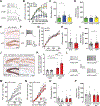Persistent ∆FosB expression limits recurrent seizure activity and provides neuroprotection in the dentate gyrus of APP mice
- PMID: 38642602
- PMCID: PMC11406539
- DOI: 10.1016/j.pneurobio.2024.102612
Persistent ∆FosB expression limits recurrent seizure activity and provides neuroprotection in the dentate gyrus of APP mice
Abstract
Recurrent seizures lead to accumulation of the activity-dependent transcription factor ∆FosB in hippocampal dentate granule cells in both mouse models of epilepsy and mouse models of Alzheimer's disease (AD), which is also associated with increased incidence of seizures. In patients with AD and related mouse models, the degree of ∆FosB accumulation corresponds with increasing severity of cognitive deficits. We previously found that ∆FosB impairs spatial memory in mice by epigenetically regulating expression of target genes such as calbindin that are involved in synaptic plasticity. However, the suppression of calbindin in conditions of neuronal hyperexcitability has been demonstrated to provide neuroprotection to dentate granule cells, indicating that ∆FosB may act over long timescales to coordinate neuroprotective pathways. To test this hypothesis, we used viral-mediated expression of ∆JunD to interfere with ∆FosB signaling over the course of several months in transgenic mice expressing mutant human amyloid precursor protein (APP), which exhibit spontaneous seizures and develop AD-related neuropathology and cognitive deficits. Our results demonstrate that persistent ∆FosB activity acts through discrete modes of hippocampal target gene regulation to modulate neuronal excitability, limit recurrent seizure activity, and provide neuroprotection to hippocampal dentate granule cells in APP mice.
Keywords: Alzheimer’s disease; Epigenetic; Epilepsy; Hippocampus; Neuroprotection; ∆FosB.
Copyright © 2024 Elsevier Ltd. All rights reserved.
Conflict of interest statement
Declaration of Competing Interest The authors declare that they have no known competing financial interests or personal relationships that could have appeared to influence the work reported in this paper.
Figures






References
-
- Aasly JO, Shi M, Sossi V, Stewart T, Johansen KK, Wszolek ZK, Uitti RJ, Hasegawa K, Yokoyama T, Zabetian CP, Kim HM, Leverenz JB, Ginghina C, Armaly J, Edwards KL, Snapinn KW, Stoessl AJ, Zhang J, 2012. Cerebrospinal fluid amyloid beta and tau in LRRK2 mutation carriers. Neurology 78, 55–61. - PMC - PubMed
-
- Amatniek JC, Hauser WA, DelCastillo-Castaneda C, Jacobs DM, Marder K, Bell K, Albert M, Brandt J, Stern Y, 2006. Incidence and predictors of seizures in patients with Alzheimer’s disease. Epilepsia 47, 867–872. - PubMed
-
- Anouar Y, Lee HW, Eiden LE, 1999. Both inducible and constitutive activator protein-1-like transcription factors are used for transcriptional activation of the galanin gene by different first and second messenger pathways. Mol Pharmacol 56, 162–169. - PubMed
MeSH terms
Substances
Grants and funding
LinkOut - more resources
Full Text Sources
Medical
Molecular Biology Databases
Miscellaneous

